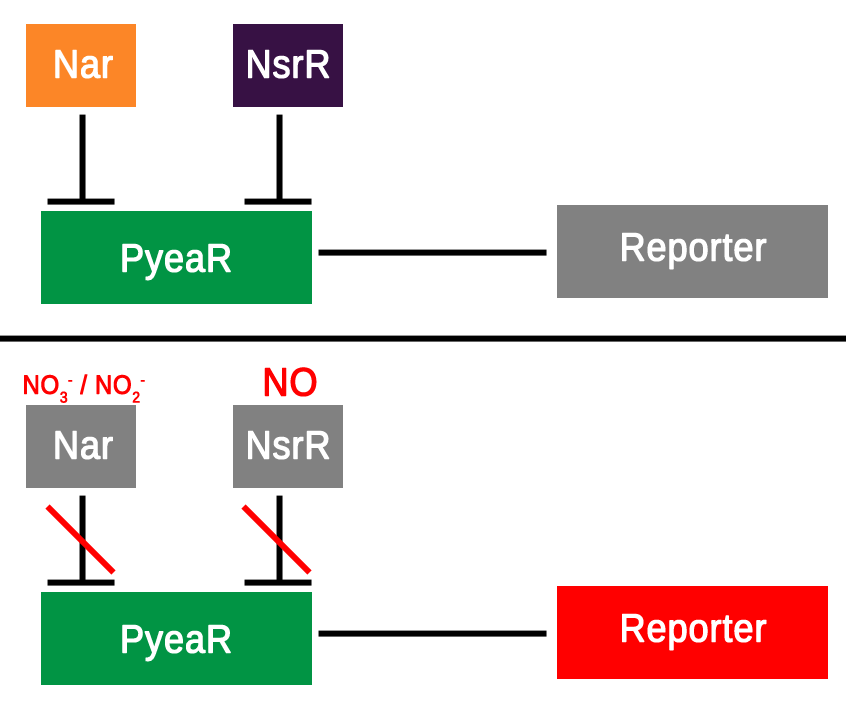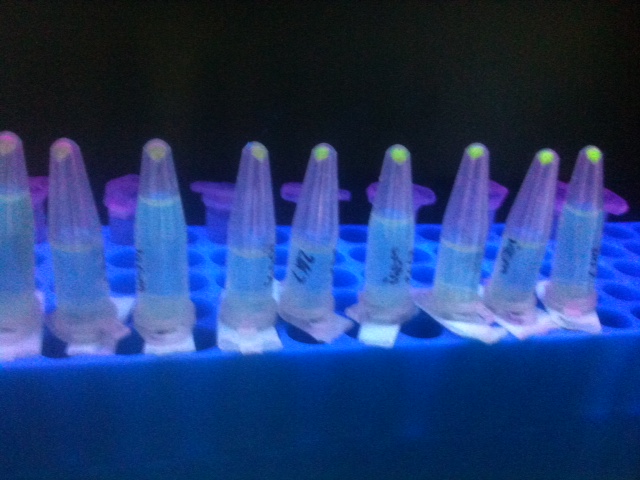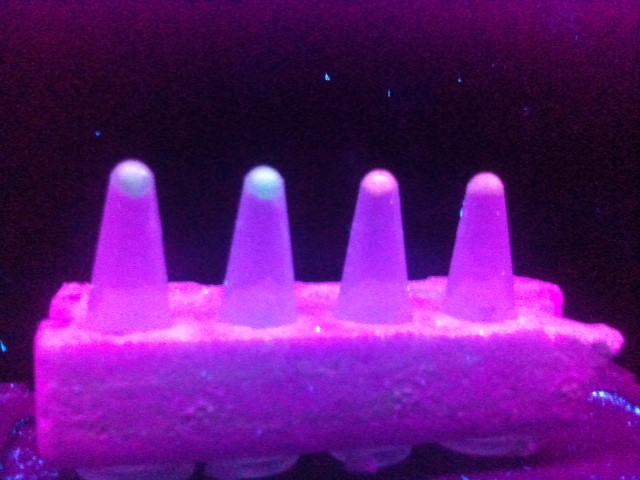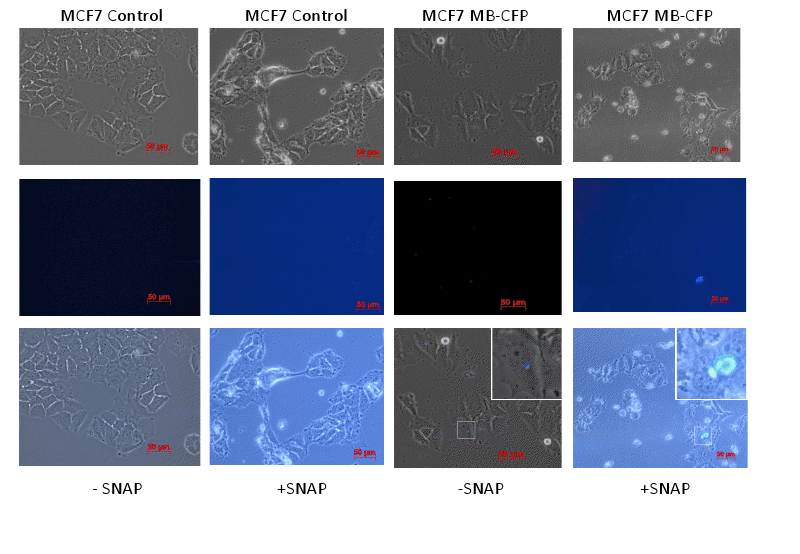Team:NRP-UEA-Norwich/NOSensing
From 2012.igem.org
Welcome to the NRP UEA iGEM 2012 Wiki Projects Menu
Please choose the relevant link to view an overview of each project!
Nitric Oxide Sensing & The Hybrid Promoters | The Comparator Circuit | Theoretical Projects
Parts produced from this project:
Bacterial-Mammalian/B-M (PyeaR-CArG) Hybrid Promoter -- Mammalian-Bacterial/M-B (CArG-PyeaR) Hybrid Promoter -- B-M + eCFP -- B-M + RFP -- M-B + eCFP -- M-B + RFP
Our main project has resulted in the production of a hybrid bacterial and mammalian promoter optimised for induction by nitric oxide, nitrates and nitrites. We have ligated PyeaR, a known bacterial promoter and Part BBa_K216005 (Cambridge 2009) in the parts registry, with its mammalian counterpart, CArG. The resulting hybrid promoter has been synthesised in two orientations; PyeaR (bacterial, B) upstream of CArG (mammalian, M), nicknamed (B-M); and CArG upstream of PyeaR (M-B). These orientations were submitted to the parts registry as our first two biobricks.
Each orientation of the promoter was ligated to enhanced cyan fluorescent protein (eCFP) and red fluorescent protein (RFP) to produce four new biobricks which have been submitted to the parts registry. These promoter + fluorescent protein biobricks have been characterised following transformation into Escherichia coli and induction by potassium nitrate using methods such as flow cytometry, fluorescence-activated cell sorting (FACS) and scanning with a fluorometer. The data from these experiments has proved that our promoter works as we expected it to. We have also transfected M-B + eCFP into a human breast cancer cell line, MCF7, and have proved the system is flexible and can be used in both eukaryotes and prokaryotes.
We believe the promoters we have produced have relevant uses in cancer therapeutics, soil fertilisation and detection of emissions from industries such as construction.

The University of East Anglia hosts many research teams whose work focuses on studying nitrogenous species and the way in which bacteria use and modify those species. One major problem that is faced by these teams involves working with nitric oxide (NO), as NO is highly reactive with a low half life, therefore making it difficult to trace and quantitatively measure accurately. Many of the methods currently used to measure NO levels are unable to distinguish between homogenous species, such as nitrates (NO3) and nitrites (NO2), therefore the figure given for NO levels is often inaccurate as other nitrogenous species are taken into account.
The ability to be able to accurately detect NO levels is one with a great deal of potential for the future. Nitric oxide has been noted as a possible cancer therapy due to its physiological use as an apoptosis inducer by macrophages, however NO is also known to be used by cancerous cells to establish a baseline and use it to induce apoptosis and promote proliferation of a tumour; being able to accurately sense nitric oxide and go on to act on that information could be very useful to prevent the NO baseline being established by cancerous cells, but to also use NO for its apoptosis-inducing abilities. There are also other potential applications in the construction business, in 2008 NEED TO FIND REFERENCE OF PEOPLE released legislation encouraging construction companies to monitor their NO output as it is inversely proportional to carbon monoxide (a toxic substance which needs to be regulated); the ability to accurately detail levels of NO being released in these circumstances would be highly useful.
Nitric oxide is an extremely physiologically relevant molecule found within both eukaryotes and prokaryotes, where it is utilised by different enzymes and systems for various roles. The aim of the experiment was to devise a hybrid promoter that could be applied to eukaryotes and prokaryotes in order to begin to more accurately sense NO and report on its specific levels.
The hybrid promoter was designed to take on both bacterial and mammalian elements in order to be compatible with both bacterial and mammalian cells. After research around the subject and searching the parts registry a promoter known as PyeaR was decided upon as the bacterial element of the hybrid promoter; PyeaR is found in the yeaR/yoaG operon of Escherichia coli and is associated with induction by nitric oxide, nitrates and nitrites (Lin et al., 2007). PyeaR is repressed by two main repressors; Nar, which is regulated by nitrates and nitrites; and NsrR, which is regulated by nitric oxide (Figure 1.). One of the key elements of PyeaR is that it is not repressed in aerobic conditions, allowing for easier carrying out of experiments. The PyeaR aspect of the hybrid promoter has been known throughout the project as the bacterial promoter, or simply B.
The mammalian element of the hybrid promoter was produced by nine CArG elements (repeated elements of CC(A/T)(6)GG), a promoter previously used synthetically for nitric oxide synthase as a cancer therapy (Worthington et al., 2005) and developed from the EGR1 gene for early growth response protein 1 (Scott et al., 2002). The CArG aspect of the hybrid promoter has been known throughout the project as the mammalian promoter, or simply M.
Following identification of the two elements of the hybrid promoters the B (PyeaR) and M (CArG) aspects were ligated to one another in two orientations; B upstream of M (B-M) and M upstream of M (M-B) (Figure 2.). The hybrid promoters were synthesised in a pUC57 backbone with the standard iGEM restriction sites of EcoR1/Xba1 upstream of the promoter, and Spe1/Pst1 downstream of the promoter. A BamH1 restriction site was included in between the B and M sequences in order to allow for the B and M elements to be separated, as well as for easy verification of the promoter having been ligated into the iGEM backbone in future experiments (as BamH1 does not already exist in the pSB1C3 backbone).
In order to begin to develop experiments to characterise the hybrid promoters + fluorescent proteins experiments were also carried out on a biobrick containing PyeaR + GFP (Part BBa_K381001, Bristol 2010). In these experiments transformed E. coli was inoculated into liquid culture, which in turn had varying potassium nitrate concentrations added to it. They were then left to grow before being spun down and viewed under a UV box in order to observe. The different concentrations of potassium nitrate that the transformed E. coli was grown in were: 0 mM, 1 mM, 2 mM, 3 mM, 4 mM, 5 mM, 6 mM, 8 mM, 10 mM.

The figure suggests that fluorescent proteins have been expressed by the bacteria grown in media containing potassium nitrate due to the fluorescence shown under the UV box. It also suggests that different concentrations of potassium nitrate correlate with different intensities of expression due to the observable differences in fluorescence as the tubes are viewed from left to right, going up the gradient. The negative control of 0 mM potassium nitrate appears to show no fluorescence, suggesting it is indeed the potassium nitrate that is inducing the promoter.
The DNA for the synthesised genes of B-M and M-B had been supplied in the pUC57 backbone, therefore it was necessary for B-M and M-B to be digested from the pUC57 backbone and ligated into the pSB1C3 backbone. The synthesised gene was transformed into competent ’’E. coli’’ cells, which in turn were grown on agar plates containing 100 µg/ml ampicillin (due to pUC57 containing ampicillin resistance); colonies that had grown were then inoculated into liquid culture, and the liquid culture was subsequently mini-prepped using either the Bioline ISOLATE Plasmid DNA Mini Kit or the Promega Wizard® Plus SV Minipreps DNA Purification System. The DNA that had been extracted through mini-preps and the pSB1C3 backbone, as provided by the iGEM registry, were then digested using EcoR1 and Pst1 and a ligation was carried out using standard assembly protocol. The product of ligation was then transformed into competent E. coli cells, which were grown on agar plates containing 2.5 µg/ml chloramphenicol (due to pSB1C3 containing chloramphenicol resistance); this was done to eliminate any bacteria that had been transformed with undesirable ligation products.
The colonies that had grown were then grown in liquid culture and mini-prepped in order to extract the DNA; the extracted DNA was then sent for sequencing, and the returned sequenced matched the expected sequence. The DNA was then sent to the parts registry as the Bacterial-Mammalian Hybrid Promoter and the Mammalian-Bacterial Hybrid Promoter. The biobricks for B-M and M-B were then used for further experiments, including ligation with a fluorescent protein reporter and growth studies.
From weeks one through to five the team worked on producing the first biobricks of the hybrid promoter. Despite this proving difficult due to various reasons such as low amounts of DNA being produced from early mini-preps and ligation strategies not working, E. coli transformed by the biobrick DNA was successfully grown and proven to have the relevant antibiotic resistance by the beginning of week six.
As part of the characterisation of the hybrid promoters, as well as PyeaR alone (Part BBa_K216005, studies were conducted to see if the growth of the E. coli was affected by transformation of the promoters.
To being untransformed E. coli were inoculated into liquid culture and left to grow overnight at 37 ºC before being diluted down. The diluted liquid cultures were run through a spectrophotometer at OD 600 nm and their absorbance noted, before each culture was plated and once again left overnight at 37 ºC; the next morning the colonies on the plates were counted, allowing a calibration curve of absorbance at OD 600 nm against colony-forming units per ml (CFU/ml) to be set up (Figure 3.)
Following establishment of the calibration curve liquid cultures were made up of E. coli that was:
. Untransformed (otherwise referred to as alpha cells)
. Transformed by B-M
. Transformed by M-B
. Transformed by PyeaR
These cultures were then diluted down to the same starting level (an OD 600 nm absorbance of 0.2 +/- 0.1) and cuvettes filled with LB media were inoculated. The cuvettes were then placed in a spectrophotometer every hour and the absorbance at 600 nm was established; in between readings the cuvettes were placed into a 37 ºC incubator in order to encourage bacterial growth. This was repeated for 12 hours and the absorbance readings compared to the calibration curve in order to give data on the level of growth of E. coli transformed with the different promoters/untransformed over time.
In order to test the activity of the hybrid promoters a reporter needed to be ligated. As the hybrid promoter did not already contain a ribosome binding site (RBS) both the RBS and the reporter were needed to be ligated to the promoter; in order to help improve experimental efficiency the parts registry was searched for relevant reporters that also contained an RBS. In week three two reporters were identified as BBa_E0420, a biobrick for enhanced CFP (eCFP) + RBS + terminators, and BBa_K081014, a biobrick for RFP + RBS + terminators.
Once the B-M and M-B biobricks had been created in week six work began in earnest on the fluorescent proteins and ligating the promoters to them in order to begin characterisation. Due to many set-backs with low levels of DNA and having to order more biobricks from the registry, a successful ligation of the promoter to a fluorescent protein reporter was finally achieved in week ten. In order to carry out the ligation the promoter was first digested using Spe1 and Pst1 in order to linearise the backbone downstream of the promoter; the fluorescent proteins were digested using Xba1 and Pst1 in order to remove the insert. A ligation was then carried out using standard assembly protocol and the ligation products were transformed into E. coli competent cells, which in turn were grown on agar plates 2.5 µg/ml chloramphenicol (due to pSB1C3 containing chloramphenicol resistance).
In order to quickly identify colonies of bacteria containing the promoter, RBS and reporter in a likely correct sequence a range of colonies were inoculated into media also containing potassium nitrate (KNO3) solution; this was done in order to inhibit the Nar repressor in PyeaR and result in activation of the promoter/induction of transcription/expression of the fluorescent protein reporter. Samples of the inoculated media containing KNO3 were then added to an eppendorf and spun down to form a pellet, which was viewed under a UV box and observed for fluorescence. After a week of various ligation and transformation experiments both promoters were successfully ligated to both fluorescent proteins and fluorescence of eCFP and RFP was observed under a UV box.
From these experiments four more biobricks were produced and submitted to the registry: B-M + eCFP, B-M + RFP, M-B + eCFP, and M-B + RFP.
In order to characterise the hybrid promoters ligated to fluorescent proteins a number of experiments were carried out to measure the level of fluorescent output at different concentrations of KNO3 (used to induce the promoter's activity). All of these experiments were carried out in week eleven
This figure appears to show fluorescence from the spun-down pellets of each hybrid promoter + fluorescent protein that had been grown in media contain potassium nitrate; it can be inferred from this that the potassium nitrate has induced the hybrid promoter, resulting in expression of the fluorescent protein reporter. The negative control of 0 mM potassium nitrate appears to show no fluorescence, suggesting it is indeed the potassium nitrate that is inducing the promoter.

The figure appears to show fluorescence from the spun-down pellets of each hybrid promoter + fluorescent protein that had been grown in media contain potassium nitrate; it can be inferred from this that the potassium nitrate has induced the hybrid promoter, resulting in expression of the fluorescent protein reporter.
The main characterisation of the biobricks was carried out using a fluorometer. Five tubes of media containing 200 µL transformed bacteria and potassium nitrate were grown for each biobrick in concentrations as follows:
. B-M + RFP with 0 mM, 5 mM, 10 mM, 15 mM and 20 mM potassium nitrate
. B-M + eCFP with 0 mM, 5 mM, 10 mM, 15 mM and 20 mM potassium nitrate
. M-B + RFP with 0 mM, 5 mM, 10 mM, 15 mM and 20 mM potassium nitrate
. M-B + eCFP with 0 mM, 5 mM, 10 mM, 15 mM and 20 mM potassium nitrate
The samples were then spun down in a centrifuge and resuspended in Tris buffer before being subjected to sonication in order to lyse the cells. The resulting solution was then spun down in a centrifuge again before the supernatant was extracted (in order to separate the proteins from the rest of the cell). The supernatant was then run through a fluorometer in order to measure the intensity of fluorescence as a method to gauge the activity of the hybrid promoters. RFP-containing samples were excited with a wavelength of 560 nm and the emission measured from 600 – 650 nm; eCFP-containing samples were excited with a wavelength of 410 nm and emission measured from 440-490 nm.
These characterisation experiments gave rise to the characterisation which is now available on the main page for all hybrid promoter + fluorescent protein parts on the registry, and the experience section of the hybrid promoters alone on the registry.
Three tubes of media were inoculated with bacteria transformed by the B-M + RFP biobrick. Each tube then had potassium nitrate added to it at different concentrations; 0 mM, 1 mM and 10 mM. The samples were grown over night and then fixed using 4% PFA, before being run through a flow cytometer for analysis.
Data
Note: This was the first time the flow cytometers at the University of East Anglia had been used with E. coli
In order to ascertain the flexibility of the hybrid promoter and help prove our original aim of producing a promoter that could be used in both eukaryotes and prokaryotes correct, the DNA for M-B + eCFP was transfected into the MCF7 human breast cancer cell line. An experiment was set up using S-Nitroso-N-acetyl-DL-penicillamine (SNAP), a nitric oxide donor, in order to induce expression of the fluorescent protein. A six-well transfection slide was produced containing:
The cells were then left for a day before they were imaged with a fluorescence microscope in order to observe expression of eCFP.

The figure appears to show fluorescence in the mammalian cells that had been transfected with M-B + CFP compared with the cells that had not been transfected. The figure also appears to show stronger fluorescence in the cells that had been transfected with M-B + CFP and had been grown with the nitric oxide donor SNAP compared to the cells that had been transfected with M-B + CFP and grown without SNAP.
The figure appears to show low levels of fluorescence in the cells as there are small blue circles appearing in the cells indicative of CFP expression.
The figure suggests that expression of CFP has occurred due to the large blue shape appearing in the centre of the image following the use of a filter to view fluorescent cyan more easily.
BM/MB better or the same, RFP/CFP better or the same etc.
. Full quantitative analysis to see where the values lie; combine with tuners for different sensitivity levels
. With different substrates (e.g. nitrite salt, NO donor)
. With different reporter/effector enzyme
Civerolo, K.L. and Dickerson, R.R. (1998) Nitric oxide soil emissions from tilled and untilled cornfields, Agricultural and Forest Meteorology, 90; 307-311
Davidson, E., (2012), Sources of Nitric Oxide and Nitrous Oxide following Wetting of Dry Soil, Soil Sci. Soc. Am. J. 56; 95–102
Lin H.Y., Bledsoe P.J., Stewart V., (2007), Activation of yeaR-yoaG Operon Transcription by the Nitrate-Responsive Regulator NarL Is Independent of Oxygen- Responsive Regulator Fnr in Escherichia coli K-12▿, Journal of Bacteriology, 189: 7539 - 7548
Lipschultz, F., Zafiriou, O.C. Wofsy, S.C., Elroy, M.B., Valois, F.W. and Watson, S.W. (1981) Production of NO and N2O by soil nitrifying bacteria, Macmillan Journals, 294; 641-643
Pasqualini, R., Koivunen, E., Kain, R., Lahdenranta, J., Sakamoto, M., Stryhn, A., Ashmun, R.A., Shapiro, L.H., Arap, W. And Ruoslahti, E. (2000) Aminopeptidase N is a receptor for tumour-homing peptides and a target for inhibiting angiogenesis, The Journal of Cancer Research, 60; 722-727
Scott S.D., Joiner M.C., Marples B., (2002), Optimizing radiation-responsive gene promoters for radiogenetic cancer therapy., Gene Therapy, 9: 1396-1402
Worthington J., Robson T., Scott S., Hirst, D., (2005), Evaluation of a synthetic CArG promoter for nitric oxide synthase gene therapy of cancer, Gene Therapy, 12: 1417–1423
Xu, W., Liu, L.Z., Loizidou, M., Ahmed, M. And Charles, I.G. (2002) The role of nitric oxide in cancer, Cell Research, 12; 311-320